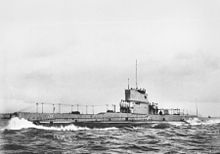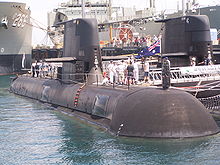Royal Australian Navy Submarine Service
The Royal Australian Navy Submarine Service is the
The Royal Australian Navy Submarine Service has been established four times, with the initial three attempts being foiled by combat losses and Australia's economic problems. The modern Submarine Service was established in 1964, and has formed an important element of the Australian military's capacity since that date. While the Submarine Service has not seen combat since World War I, Australian submarines have conducted extensive surveillance operations throughout
The current Director General Submarines is Commodore T. Phillips, RAN.
History
The Royal Australian Navy's submarine service has been established four times since 1914.[1]
1914 to 1945
After the formation of the navy upon Federation, a period of uncertainty had followed as the size of the force to be established was determined. Eventually, this was set at 13 vessels, including three submarines.

AE2 remained in the South Pacific until December 1914, when she was ordered to the Mediterranean to support the British-led operations off the

The Australian submarine service was reformed in 1919, when the British government transferred six
The Australian submarine service was established a third time in 1927, when the British

The Australian ports of
1945 to present
Following World War II the Royal Navy's

The first Australian Oberon class submarine,
The six Collins class submarines were the first Australian-built submarines, and the most expensive ships to have been built in Australia. The Collins class submarines were built by the
Like the Oberon class, the Collins-class submarines have conducted surveillance patrols. In 1999, it was reported that Waller and a second boat operated in support of the
In 1998, the Royal Australian Navy became the fourth Navy in the world to permit women to serve on board submarines. The first female submariners began their training at the Submarine Training and Systems Centre in June 1998.[27]
Today

The Royal Australian Navy Submarine Force Element Group Headquarters, and all six of the Collins Class submarines, are at HMAS Stirling located on Garden Island, near Perth. The majority of the Navy's submarine support facilities are also located at HMAS Stirling, including the Submarine Escape Training Facility. The LR5 submersible, which is contracted to provide the RAN's submarine rescue capability, has been based at nearby Henderson, Western Australia since June 2009.[28]
Under current Royal Australian Navy doctrine, the Submarine Service has the following responsibilities:[29]
- intelligence collection and surveillance;
- maritime strike and interdiction;
- barrier operations;
- advanced force operations;
- layered defense;
- interdiction of shipping;
- containment by distraction; and
- support to operations on land
In early 2007, it was reported that Submarine Service was experiencing severe shortfalls in personnel and had only 70% of its authorised strength of 500 sailors. These shortfalls were reported to have reduced the service's operational readiness and forced HMAS Collins to be temporarily withdrawn from service.[30]
Future submarines
This section needs to be updated. (September 2021) |
The Collins class submarines will begin to reach the end of their useful life from 2026.
In September 2013,
In 2016, France won a contract to build a conventionally-powered variant of its Barracuda-class submarine for Australia.[34]
In September 2021, the Australian government announced that the deal with France had been scrapped, and that Australia would be working with the United States and United Kingdom to acquire at least eight conventionally-armed nuclear powered submarines as part of the new AUKUS security partnership.[35][36]
Three prototype autonomous underwater vehicles were ordered for the RAN in May 2022, designated the Ghost Shark. The first prototype was publicly revealed in April 2024.[37][38]
Dolphin badge
Australian sailors who qualify as submariners are awarded a badge depicting two dolphins and a crown. This badge (known as a sailor's 'dolphins') was designed by Commander Alan McIntosh RAN, and was introduced in 1966; a similar badge was adopted by the Royal Navy Submarine Service in 1972.[39]
See also
Notes
Footnotes
Citations
- ^ a b c "A Brief History of the Royal Australian Navy's Submarine Service". Royal Australian Navy. Archived from the original on 22 July 2008. Retrieved 22 March 2013.
- ^ Whitley 2000, p. 17.
- ^ a b Gillett & Graham 1977, p. 193.
- ^ "HMAS AE1 World War I submarine found after century-long search". ABC News. Retrieved 21 December 2017.
- ^ Jose 1941, pp. 240–248.
- ^ John Davison and Tom Allibone (2005). Beneath Southern Seas: The Silent Service. University of Western Australia Press. p. 126.
- ^ Sears, in The Navy and the Nation, p. 86
- ^ "The Pioneers". Submarines Association of Australia. Archived from the original on 9 December 2006.
- ^ Carruthers 2006, p. 151.
- ^ Davison and Allibone (2005). p. 219.
- ^ Cooper, in The Royal Australian Navy, p. 194
- ^ White, Australian submarines, pp. 191–200.
- ^ 'Cat and Mouse' Archived 18 September 2006 at the Wayback Machine in Reveille, September/October 2006.
- ^ Undersea missions to surface. The Daily Telegraph, 7 September 2006.
- ISSN 1038-8761. Retrieved 26 December 2015.
- ^ Patrick 2014, p. 37.
- ^ Linton & Donohue 2015, pp. 285–286.
- ^ Expert Panel to Review SAS Veterans' Health Concerns 2003, pp. 73–74.
- ^ Shaw, HMAS Onslow, p. 10
- ^ Australian Submarines Association, The Oberon Era Archived 18 November 2006 at the Wayback Machine
- ^ Frame, No Pleasure Cruise, pp. 284–285.
- ^ Hyland, Arms race' leaving our subs all at sea
- ^ Paul Daley Terms of Engagement. The Age 29 August 2000.
- ^ Farrell, Peacemakers, p. 66.
- ^ Australian National Audit Office, "2014–15 major projects report : Department of Defence"
- ^ Navy forced to reduce subs' diving depth. The Age 23 July 2005.
- ^ Australian Parliamentary Library E-Brief Women in the armed forces: the role of women in the Australian Defence Force Archived 7 February 2012 at the Wayback Machine
- ^ Fish, Tim; Scott, Richard (17 June 2009). "LR5 sub rescue system moves Down Under". Jane's Navy International. IHS (Global) Limited. Retrieved 2 August 2009.
- ^ Seapower Centre – Australia. Navy Contribution to Australian Maritime Operations Archived 26 September 2008 at the Wayback Machine
- ^ Walters, Patrick. "Higher pay for sailors in subs". The Australian.
- ^ Submarine Institute of Australia. Australia’s Future Underwater Warfare Capability – Project SM 2020 Archived 20 August 2006 at the Wayback Machine
- ^ Patrick Walters (2006). Cutting Edge: The Collins experance. Australian Strategic Policy Institute, Canberra. pp. 10–11.
- ^ Rear Admiral Gregory Sammut, Official Biography (RAN), accessed 2021-09-19
- ^ "France wins A$50bn Australia submarine contract". BBC News. 26 April 2016. Retrieved 20 January 2022.
- ^ "Aukus: UK, US and Australia launch pact to counter China". BBC News. 16 September 2021. Retrieved 20 January 2022.
- ^ Prime Minister; Minister for Defence; Minister for Foreign Affairs; Minister for Women (16 September 2021). "Australia to pursue Nuclear-powered Submarines through new Trilateral Enhanced Security Partnership". Prime Minister of Australia (Press release). Archived from the original on 27 September 2021. Retrieved 25 September 2021.
 This article contains quotations from this source, which is available under a Creative Commons Attribution 4.0 International Licence.
This article contains quotations from this source, which is available under a Creative Commons Attribution 4.0 International Licence.
- ^ Tucker, Patrick (22 April 2024). "Australia got a new sub drone far faster than the US Navy could have, company says". Defense One. Retrieved 28 April 2024.
- ^ "Defence and Anduril unveil first Ghost Shark prototype". Australian Defence Magazine. 18 April 2024. Retrieved 28 April 2024.
- ^ Seal 2013, pp. 4–5.
References
- "A Brief History of the Royal Australian Navy's Submarine Service". Royal Australian Navy. Archived from the original on 22 July 2008. Retrieved 22 March 2013.
- "The Trade". Royal Australian Navy.
- "Navy Contribution to Australian Maritime Operations". Seapower Centre – Australia. Archived from the original on 26 September 2008.
- "Submarines Association of Australia website".
- "Submarine Institute of Australia website".
- Daley, Paul. (29 August 2000). "Terms of Engagement". The Age.
- Expert Panel to Review SAS Veterans' Health Concerns (2003). Final report of the Expert Panel to Review SAS Veterans' Health Concerns (PDF). Retrieved 21 December 2016.
- "Cat and Mouse" (PDF). Reveille. September–October 2006. Archived from the original (PDF) on 18 September 2006. Retrieved 17 September 2006.
- "Undersea missions to surface". The Daily Telegraph. 7 September 2006.
- "Women in the armed forces: the role of women in the Australian Defence Force". Australian Parliamentary Library E-Brief. Archived from the original on 7 February 2012.
- Australian National Audit Office (2016). "2014–15 major projects report : Department of Defence" (PDF). Report on Ministerial Portfolios. Budget Sittings. Canberra, ACT: Commonwealth of Australia. ISSN 1036-7632. Retrieved 11 December 2016.
- Carruthers, Steven (2006) [1982]. Japanese Submarine Raiders 1942: A Maritime Mystery (Revised ed.). Narrabeen: Casper Publications. ISBN 0-9775063-0-4.
- Cooper, Alastair (2001). "The Era of Forward Defence". In Stevens, David (ed.). The Royal Australian Navy. The Australian Centenary History of Defence (vol III). South Melbourne, Victoria: Oxford University Press. OCLC 50418095.
- Davison, John; Allibone, Tom (2005). Beneath Southern Seas: The Silent Service. University of Western Australia Press. ISBN 1-920694-62-5.
- Farrell, John (2000). Peace Makers: INTERFETs Liberation of East Timor. Rocklea: Fullbore. ISBN 0-646-39424-X.
- Gillett, Ross; Graham, Colin (1977). Warships of Australia. Adelaide, South Australia: Rigby. ISBN 0-7270-0472-7.
- OCLC 55980812.
- Hendricks, David M. "The Submarine Force of the Royal Australian Navy".
- Hyland, Tom (6 May 2007). "'Arms race' leaving our subs all at sea". The Age. Retrieved 13 December 2016.
- Jose, Arthur (1941). The Royal Australian Navy, 1914–1918. Official History of Australia in the War of 1914–1918. Vol. IX (9th ed.). Canberra: Australian War Memorial. OCLC 271462423.
- Linton, Commander E.W. (Jake); Donohue, Commodore H.J (Hec) (2015). United and Undaunted: The First 100 Years: A History of Diving in the Royal Australian Navy 1911–2011. Queanbeyan, New South Wales: Grinkle Press. ISBN 9780980282153.
- ISSN 1446-6880.
- Seal, Graham (2013). Century of Silent Service. Salisbury, Queensland: Boolarong Press. ISBN 9781922109897.
- Sears, Jason (2001). "Depression and Rearmament". In Stevens, David (ed.). The Royal Australian Navy. The Australian Centenary History of Defence (vol III). South Melbourne, Victoria: Oxford University Press. OCLC 50418095.
- Shaw, Lindsey (2005). HMAS Onslow: Cold War Warrior. Sydney, NSW: Australian National Maritime Museum. OCLC 225390609.
- Walters, Patrick (2006). Cutting Edge: The Collins experience. Canberra: Australian Strategic Policy Institute.
- White, Michael (1992). Australian Submarines: A History. Canberra: Australian Government Publishing Service. ISBN 0-644-24397-X.
- Whitley, M.J. (2000) [1988]. Destroyers of World War Two: An International Encyclopedia. London: Cassell. ISBN 1-85409-521-8.
